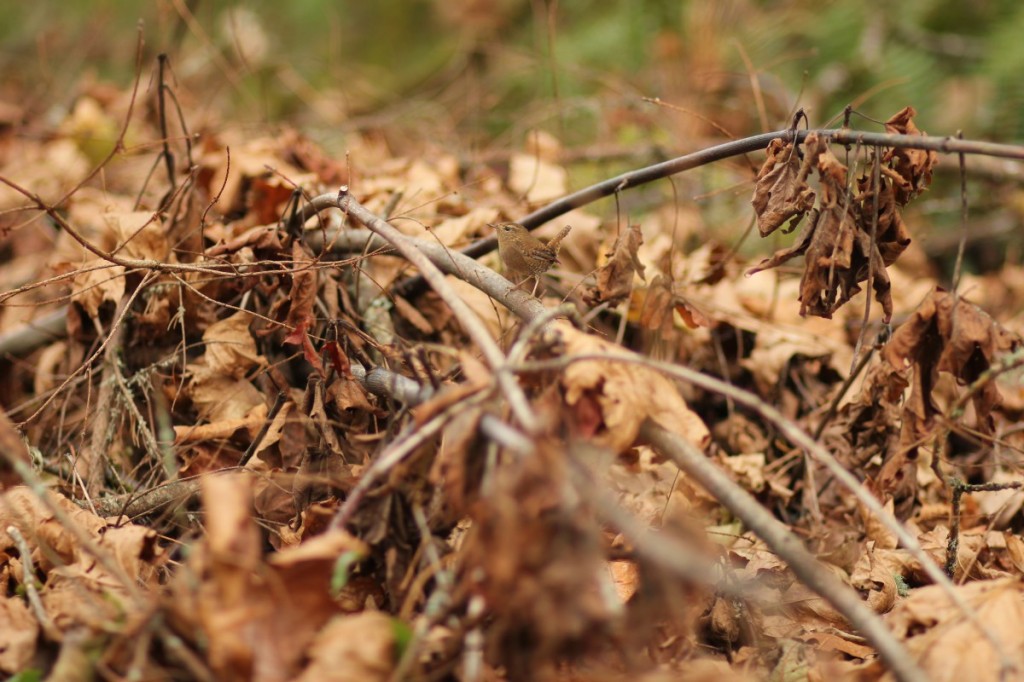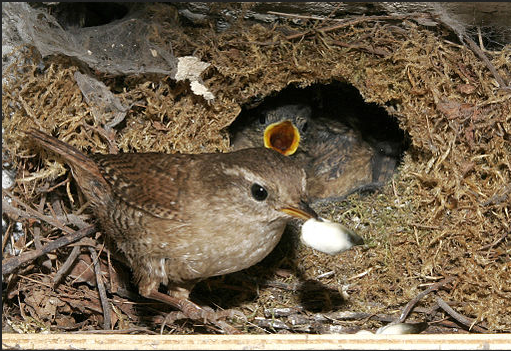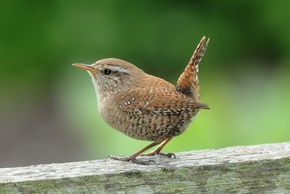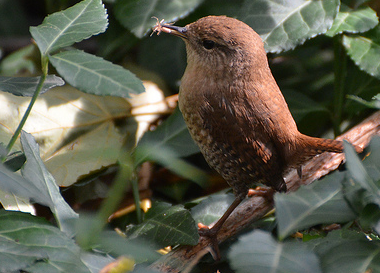Order: Passeriformes
Family: Troglodytidae
Genus: Troglodytes
Species: Troglodytes pacificus
Introduction
The Pacific Wren can often be heard before it is seen as it darts between the shrubs and understory vegetation of coniferous forests, calling as it goes. Among the smallest of the wrens in the Troglodytidae family, the Pacific Wren (Troglodytes pacificus) weighs approximately 9 g, measures 10 cm in length and has a wingspan of 14 cm (Sibley 2003). Their plumage is dark brown with dark, heavily barred flanks and a distinctive short, buff stripe over the eye. Bill and legs are light to dark brown. This small songbird hops about with its short tail cocked upright over its back. Male and female birds look alike, with no distict differences in plumage (Toews and Irwin 2012)
Pacific Wrens often share a habitat with other small passerines such as chickadees, nuthatches and creepers. The Pacific Wren has only recently been distinguished from the Winter Wren (Troglodytes hiemalis) of eastern North America, as relevant studies have shown the two to be genetically and phenotypically distinct (Toews and Irwin 2008). Since the two species share similar habitat and food preferences, this divergence is likely the result of sexual selection and not because of ecological pressures. This is also evident in the variation of songs between the two species (Kroodsma 1980).
Year-round (resident) ranges of the Pacific Wren extend along the Pacific Coast from the Aleutian Islands and Alaskan coast south to Central California, and in the Rocky Mountains from Western Alberta to Northern Colorado (Toews and Irwin 2012).

Taken by Karla Kelly behind Capital High School, West Olympia
21 November 2014
The Pacific Wren lives in understory vegetation of coniferous and mixed coniferous/deciduous forests. Pacific Wrens live close to the forest floor and do not generally venture more than 3 m up from the ground. Areas with dense shrub and coarse woody debris are favored territories (Toews and Irwin 2012). Riparian zones are also generally preferred because riparian zones tend to contain more shrubs than upland habitats (Pearson and Manuwal 2001). Salmon biomass accumulation in riparian zones is shown to increase invertebrate populations, which in turn provide food to increase Pacific Wren populations; studies of Pacific Wren tissues show isotopic evidence of salmon-derived nitrogen present (Field and Reynolds 2011). It has also been shown that there is a larger abundance of passerines (including Pacific Wrens) in riparian zones at the bottom of a waterfall of a salmon-containing stream. This is because there are more salmon-derived nutrients collected at the bottom of the falls than at the top of the falls (Christie and Reimchen 2008). Although it is possible for Pacific Wrens to breed at higher elevations, it has been shown that there is an increased amount of unmated males in these territories than in the lower elevations.. Among the mated males that do hold territory at higher elevations, those territories will hold fewer nests than those of Pacific Wrens in subalpine zones. Males who have nested in high elevations are also shown to not return to these breeding sites in following years, indicating that high elevations lead to unsuccessful breeding in Pacific Wrens (Evans Ogden et. al. 2012).
Pacific Wrens are primarily insectivores, and rarely eat plant material. The Pacific Wren actively gleans insects and other arthropods from the nooks and crevices of plants, woody debris, rocks and substrate using their slender bills. They have been observed feeding their young small grubs and worms on occasion (Toews and Irwin 2012).
Like hummingbirds and other small, highly active birds, the wren requires a large amount of food in relation to body mass. Fledged young have been observed eating more than their own weight in food when conditions are ideal. A wren’s diet is mostly protein-based, although in winter when insects are harder to come by, it is not uncommon for wrens to eat seeds as well (Armstrong 1955).
SONG
CALL
Recorded behind Capital High School on 21 November 2014 by Karla Kelly.
CALL
Recorded in TESC C Lot on 21 November 2014 by Karla Kelly.
CALL
Recorded in TESC B Lot on 14 October 2014 by Karla Kelly.
Singing:
Male Pacific Wrens have a vocal repertoire of 30 or more distinct and complex songs. Winter Wrens, however, have only 2 songs in their repertoire. A Pacific Wren’s song is also faster and even more complex than the Winter Wren’s song, with almost twice as many notes per song (Kroodsma 2005).Males in neighboring territories will often share songs with one another, which serves as a form of communication. The songs are usually similar in length, syntax, and composition. Wrens further apart from each other will have fewer songs in common. It is believed that this is how males recognize one another and identify intruders (Camacho-Schlenker et. al. 2011).
An important factor of wren’s territory defenses involves singing before sunrise. An unthreatened male will sing earlier before dawn and will sing more songs for a longer period of time. Threatened males will sing later after sunrise and will not sing as many songs or as frequently. This shows that a short-term situation, such as an intruder, will effect the singing of the territorial male up to 24 hours after the incident (Amrhein and Erne 2006). It has also been shown that male wrens will respond to intruders in their territories differently, depending on if the intruder is moving or stationary. If an intruder has entered their territory and has changed locations, the wren will sing earlier and more often the next day. However, when the intruder remained in one location, the wren sang later and less frequently the next day (Amrhein and Lerch 2010). Furthermore, if a foreign wren’s song is heard a far distance from a male’s territory, the resident male will respond at a higher perch than if the foreign wren is heard closer. This is believed to be because the song will travel a further distance from the higher perch so that the foreign wren is more likely to hear the resident wren’s territory defense song (Mathevon and Aubin 1997).
In order to maximize song propagation, male Pacific Wrens will sing differently in the presence of environmental noise (an ocean, for example) and in the presence of man-made noise (a freeway, for example). In a study, it was found that wrens in a naturally noisy environment (near a shoreline), sang songs with longer syllables and sang more songs in their repertoire, although frequency did not change. Wrens near a freeway (man-made, non-natural noise), sang longer songs, but no other variables were recorded to be distinctly different. The songs of wrens close to the shoreline closely resembled the characteristics of wrens at any distance away from the shoreline, showing that non-natural noise had the largest impact of the singing behaviors of Pacific Wrens (Gough et. al. 2014).
Breeding:

Pacific Wren Feeding Young in Nest
By Tanja Kübelbeck (own picture –Kuebi 16:42, 5 May 2007 (UTC)) [GFDL (http://www.gnu.org/copyleft/fdl.html) or CC-BY-SA-3.0 (http://creativecommons.org/licenses/by-sa/3.0/)], via Wikimedia Commons
During courtship displays the male will quiver his wings while keeping them drooped and close to the body. The male will adopt a squatting stance and flick his tail from side to side. This culminates into a display where the male will drop his wings and move them forward and backward in a swift fanning motion (Bent 1964).
Females lay anywhere from 3 to 10 small white eggs with brownish mottling of varying darkness. The eggs are incubated for 12-15 days, and both parents feed the young until the young fledge at 10 to 17 days of life. The parents may continue to feed the fledged young for two weeks, unless the female begins another clutch, in which case the male takes sole responsibility for the brood (Bent 1964).
Pacific Wrens are not recognized by the IUCN Red List and are not a Species of Concern for Washington State. Examining data taken from two expansive yearly surveys (North American Breeding Bird Survey) the current trend of the Pacific Wren population can be seen. The Breeding Bird Survey (BBS) data shows somewhat of a decline in population numbers (Fig. 1 & Fig. 2). One of the biggest contributing factors to Pacific Wren population decline is habitat loss/urbanization. Direct habitat loss and competition with other native generalists, such as the Bewick’s Wren, means less space and resources for the Pacific Wren (Farwell and Marzluff 2013). Forest management practices are important to maintaining Pacific Wren populations. Forests that are thinned instead of clear-cut help increase Pacific Wren populations. Thinning allows more light to penetrate the forest canopy which promotes understory growth, which is the ideal habitat for Pacific Wrens (Matsuoka et al 2012). However, thinning slows the development of old growth forests, which are important in the territories of Pacific Wrens, as well as many other bird species, especially those who prefer the forest canopy (Schuster and Arcese 2012). A higher abundance of old growth forest stands provide the wrens with a higher abundance of suitable land for territories, which contribute to higher nest success rates (Hutto et. al. 2014).
Elevation models can help to predict where ideal environmental factors for Pacific Wrens will be in the future as climate change effects occur. Temperatures in the Pacific Northwest are likely to rise by 1.8°C (3.2°F) by the 2040s (from average annual temperatures taken from the 1970s to 1999) (Siegel et al 2012). This rise in temperature will influence the precipitation and temperature ranges within different elevations and can be used to predict where future habitat conservation efforts can be focused for individual species, like the Pacific Wren.

 *BBS (Breeding Bird Survey) information taken from USGS (U.S. Geological Survey) https://www.pwrc.usgs.gov/bbs/index.cfm?CFID=1483125&CFTOKEN=98ef627ee106abf3-190B53C2-C977-3CA7-E86F98D903E97ED7
*BBS (Breeding Bird Survey) information taken from USGS (U.S. Geological Survey) https://www.pwrc.usgs.gov/bbs/index.cfm?CFID=1483125&CFTOKEN=98ef627ee106abf3-190B53C2-C977-3CA7-E86F98D903E97ED7
Date: 13 November 2014
Location: TESC forest (47° 4′ 47″ N 122° 58′ 47″ W) to TESC beach (47° 4′ 52″ N 122° 58′ 55″ W)
Weather: Overcast, 10° C (50° F)
Notes: As I was walking, I would hear a Pacific Wren begin to call. As I got closer to the bird, the song would become more aggressive (louder, faster). If I continued to get closer to the bird, eventually the bird would become silent. When the bird was silent, it stayed closer to the ground, but when the call was more aggressive, the bird was often standing on a higher branch or log. As the bird called, it would hop/fly to high points in the territory.
Date: 19 November 2014
Location: Near Capitol High School (47° 3′ 3″ N 122° 55′ 53″ W)
Weather: Partly cloudy, 5° C (41° F)
Notes: I observed three distinct Pacific Wren territories. Each territory had two individuals (one male and one female). In response to playback, the wrens would call and hop/fly through territory, mostly on higher branches or logs. I found that the wrens became more excited when I played a recording of a song rather than of the call. One of the wrens sang a full song on two occasions in response to playback of an unfamiliar Pacific Wren’s song. This individual also sang partial songs multiple times in response to playback (song).
Date: 26 November 2014
Location: TESC forest (47° 4′ 47″ N 122° 58′ 47″ W) to TESC beach (47° 4′ 52″ N 122° 58′ 55″ W)
Weather: Overcast, 13° C (55° F)
Notes: I noticed very similar territorial behavior (described in previous notes) as I approached the Pacific Wren’s “chit-chit-chit” call. The wren quieted down after a few moments of stillness and I observed him picking at leaves close to the forest floor. I assume he was picking insects off of the leaves and moss on the ground. The leaves were dead.
Date: 01 December 2014
Location: TESC forest (47° 4′ 47″ N 122° 58′ 47″ W) to TESC beach (47° 4′ 52″ N 122° 58′ 55″ W)
Weather: Sunny, 4° C (39° F)
Notes: Typical territorial behavior observed. The wren usually begins this behavior when I am within about 2 meters of the bird at least. Then as I get closer (about 1 meter), his calls become more aggressive. As he hops from different perches in his territory, I notice that he is usually covering about a 2 m circumference.
*Armstrong, E. A. The Wren. St. James Place, London: Collins; 1955
*Amrhein, V., and N. Erne. 2006. Dawn Singing Reflects Past Territorial Challenges in the Winter Wren. Animal Behaviour 71:1075-1080
*Amrhein, V., and S. Lerch. 2010. Differential Effects of Moving versus Stationary Territorial Intruders on Territory Defense in a Songbird. Journal of Animal Ecology 79:82-87
Bent, A. C. 1964. Life Histories of North American Nuthatches, Wrens, Thrashers, and Their Allies. New York: Dover Publications, Inc.
*Camacho-Schlenker, S., H. Courvoisier, and T. Aubin. 2011. Song Sharing and Singing Strategies in the Winter Wren (Troglodytes troglodytes). Behavioural Processes 87:260-267.
*Christie, K. S. and T. E. Reimchen. 2008. Presence of Salmon Increases Passerine Density on Pacific Northwest Streams. The American Ornithologists’ Union. 125.1.51.
*Evans Ogden, L. J., M. Martin, and K. Martin. 2012. Mating and Breeding Success Decline with Elevation for the Pacific Wren (Troglodytes pacificus) in Coastal Mountain Forests. The Wilson Journal of Ornithology 124.2:270-276.
Farwell, L. S., and J. M. Marzluff. 2013. A New Bully on the Block: Does Urbanization promote Bewick’s Wren (Thyromanes bewickii) Aggressive Exclusion of Pacific Wrens (Troglodytes pacificus)?. Biological Conservation 161:128-141.
Field, R. D. and J. D. Reynolds. 2011. Sea to Sky: Impacts of Residual Salmon-derived Nutrients on Estuarine Breeding Bird Communities. Proceedings of the Royal Society B 278:3081-3088.
*Gough, D. C., D. J. Mennill and Nol, E. 2014. Singing Seaside: Pacific Wrens (Troglodytes pacificus) Change Their Songs in the Presence of Natural and Anthropogenic Noise. The Wilson Journal of Ornithology. 126:269-278.
*Hutto, R. L., A. D. Flesch and M. A. Fylling. 2014. A Bird’s-Eye View of Forest Restoration: Do Changes Reflect Success?. Forest Ecology and Management 327:1-9.
*Kroodsma, D. E. The Singing Life of Birds: The Art and Science of Listening to Birdsong. New York, NY: Houghton Mifflin Company; 2005
*Kroodsma, D. E. 1980. Winter Wren Singing Behavior: A Pinnacle of Song Complexity. The Condor 82.4:357-365.
*Mathevon, N., and T. Aubin. 2012. Reaction to Conspecific Degraded Song by the Wren Troglodytes troglodytes: Territorial Response and Choice of Song Post. Behavioural Processes 39:77-84.
Matsuoka, S. M., J. A. Johnson and D. A. Dellasala. 2012. Succession of Bird Communities in Young Temperate Rainforests Following Thinning. The Journal of Wildlife Management 76(5):919-931.
*Pearson, S. F. and D. A. Manuwal. 2001. Breeding Bird Response to Riparian Buffer Width in Managed Pacific Northwest Douglas-Fir Forest. Ecological Applications. 11:840-853.
*Schuster, R. and P. Arcese. 2012. Using Bird Species Community Occurrence to Prioritize Forests For Old Growth Restoration. Ecography. 36:499-507.
*Sibley, D. A. 2003. The Sibley Field Guide to Birds of Western North America. New York: Alfred K. Knopf
Siegel, R. B., R. L. Wilkerson, R. C. Kuntz, J. F. Saracco and A. L. Holmgren. 2012. Elevation Ranges of Birds at Mount Rainier National Park, North Cascades National Park Complex, and Olympic National Park, Washington. Northwestern Naturalist 93:23-39.
The National Audubon Society 2014. The Christmas Bird Count historical results. http://netapp.audubon.org/CBCObservation/Historical/ResultsBySpecies.aspx?1
*Toews, D. P. L., and D. E. Irwin. 2012. Pacific Wren (Troglodytes pacificus). The Birds of North America Online (A. Poole, Ed.). Ithaca: Cornell Lab of Ornithology; Retrieved from the Birds of North America Online: http://bna.birds.cornell.edu/bna/species/720. Web. 7 Dec. 2014
Toews, D. P. L., and D. E. Irwin. 2008. Cryptic Speciation in a Holarctic Passerine Revealed by Genetic and Bioacoustic Analyses. Molecular Ecology 17: 2691-2705.
United States Geological Survey 2014. Breeding Bird Survey raw data. https://www.pwrc.usgs.gov/bbs/RawData/Choose-Method.cfm
*Verner, J. and M. F. Willson. 1966. The Influence of Habitats on Mating Systems of North American Passerine Birds. Ecology 47:143-147.
* indicates literature added by Karla Kelly during article revision of Fall Quarter, 2014
*Updated and revised by James Titus, TESC Winter Quarter 2014
*Updated and revised by Karla Kelly, TESC Fall Quarter 2014




